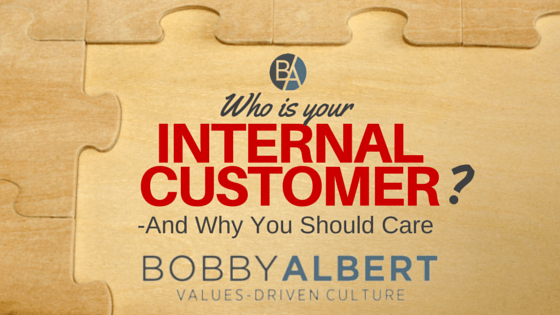About 20 years ago, I experienced the largest failure that I have ever encountered. I had invested about 4 million dollars to develop a new service – and I eventually had to shutter the whole operation. – Ouch!

Failure has a way of waking you up. And it’s not a gentle rousing. It’s more like someone grabbing you by the shoulders and giving you a good shake!
One of the truths I learned from this failure was the business was not mine. I was merely a steward of the business that God had entrusted to me.
A byproduct of failure can be progress. If you respond to failure in a healthy way, it can sharpen your focus and strengthen your resolve.
That’s what happened not long after my big failure. I discovered the Nside/Outside principle and rolled it out to our entire organization.
It is a surprisingly simple principle. It focuses on the internal customer rather than the external customer.
I know, you may be asking, “I thought everything and everyone are all eyes on the external customer?” Yes, it is all about service excellence for the external customer.
Sometimes you’ve got to focus on an uncommon objective to reach your final destination!
In fact, my company experienced remarkable results, once we incorporated this principle into our organization. The Nside/Outside principle highlights the relationship between the internal customer and the internal supplier.
We learned that:
[Tweet “Our service to our external customer can only be as good as our service to each other. -Bobby Albert #valuesdrivenculture”]
When I introduced the Nside/Outside principle, we closed our business for half a day.
And I started the morning out with a game that I called “One Body, Many Parts.” The name is inspired by 1 Corinthians 12:12 which reads: “Just as a body, though one, has many parts, but all its many parts form one body, so it is with Christ.” NIV
I’ve made a simple game instruction sheet that describes the game in detail. It’s FREE, and you can download it immediately by <clicking here>. Feel free to print it or save it for your own use.
We formed teams to play the game. The objective of the game was for each team to put a child’s eight-piece puzzle together within a short time limit. The game had specific rules that required teamwork to get the job done.
The team that followed the instructions and finished first received a prize.
We also had everyone return to their tables for open discussion about what they had learned.
Our employees learned:
- They did not communicate well with clarity and conciseness.
- By the time the instructions got to the person with the puzzle, the instructions often were incorrect and incomplete.
- As a team, they did not function as well as they thought they would.
In light of their poor performance in this simple game, everyone was ready to learn about the Internal Customer Principle.
Every person can learn the internal customer principle by asking two questions.
Who is my Internal Customer?
Internal customer and internal supplier are terms we use to describe relationships within our own organization.
An internal customer is a person or group that receives products or services from an internal supplier.
These internal customer/supplier interactions typically do not involve prices or fees since the customers and suppliers are members of the same organization.
Anyone who must rely on you for information, help, support, cooperation, resources, and the like is, by definition, your internal customer.
The person that you would normally call your customer is, more specifically, your external customer. Everyone in your organization must serve the external customer… or support someone who does.
Whether someone is an internal or external customer, they want products or services which meet or exceed their expectations.
And they expect to receive exactly what was agreed upon, and within the timeframe it was promised to be delivered!
At various times, your role will change. You and your co-workers will tend to be both an internal customer and an internal supplier.
Why Is This Important?
Everyone has a customer… everyone!
Great customer service begins by providing outstanding service to your co-workers.
To get things right for the external customer, you have to get things right for the internal customer first.
The best interest of the external customer is, in fact, the best interest of the employees and is the best way to help your organization to succeed.
Taking care of the internal customer puts the external customer contact person in the position to win.
Everyone must understand how their work makes a difference to the external customer.
This understanding enables us to “delight” external customers with exceptional experiences and deliver memorable products and services.
Don’t forget to download my FREE printable instruction sheet that describes the game mentioned above. This game is a leadership tool that you can use to encourage discovery and deeper learning throughout your organization.
Have you ever considered the Internal Customer Principle? Who is your internal customer? Please share your thoughts <here> and share this blog post with a friend or co-worker.
